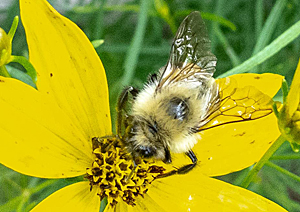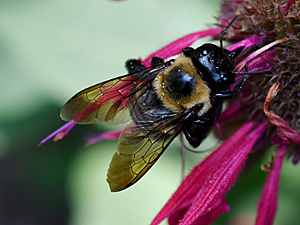Native Bees
There are about 4000 species of bees native to the United States, about 400 of which can be found in Virginia.
The bee we are most familiar with, the honeybee, is not a native. It was brought to America during Colonial times in the 1600s. Unlike honeybees, which live in large groups and build hives, many native bees are solitary, the female building small cavities where she lays her eggs.
An interesting fact about bees is that they can see ultraviolet colors, so they cannot see red very well which is at the other end of the light spectrum. That is why they are attracted to flowers that are blue, purple, orange, yellow, and white.
Why Native Bees are Important
Bees are among the most efficient pollinators in nature, pollinating wildflowers, flower and vegetable gardens, orchards, and agricultural fields.
While many native bees are generalists and are attracted to any nectar-bearing plant, others are specialists and need certain native plants to survive.
Types of Native Bees

Two-spotted Bumblebee on Coreopsis
Photo by Anne Owen
Bumblebees (Bombus spp.). Bumblebees are the largest bees common to our vegetable and flower gardens. The name “bumblebee” comes from the humming sound they make. They were originally called “humble-bees,” and there are many references to humble-bees in literature, although that name is no longer used.
Bumblebees are social insects, living in colonies with a single queen although these groups are smaller than honeybee colonies.
Unlike many other native bees, bumblebees are generalists and are attracted to any source of nectar they can find.
Carpenter Bees (Xylocopa spp.). Carpenter bees get their name from their habit of boring holes in wood, including houses and barns. They are solitary and do not live in large groups.
Carpenter bees emerge from hibernation in the spring and mate. The female then begins to excavate a tunnel about the thickness of a pencil. She creates five or six cells in the tunnel, laying a single egg in each, filling the cell with pollen and nectar for the larva to feed on when it hatches, and sealing it up with sawdust created when she dug the tunnel. The new adult bees emerge during the summer. The bees then hibernate over the winter in the existing tunnels.
Leafcutter Bees (Megachilidae Family). Leafcutter bees are a large family of native bees and an important pollinator of fruits, vegetables, and wildflowers. They get their name from their habit of cutting small sections of leaves which they use to construct their nests.
Female leafcutter bees build nests in cavities in rotting wood and other holes they find. They create a cell in the back of the hole, placing a single egg and a ball of pollen in it, sealing up the cell with chewed leaves, and then repeating the process. The larvae overwinter in their cells, emerging in the spring as adults.

Eastern Carpenter Bee on Bee Balm
Photo by Amie Ware
Mason Bees (Osmia spp.). Mason bees are smaller bees, often with some blue or green on their body. Their name comes from their habit of using mud to seal the cells where they lay their eggs. They are solitary and do not live in large groups.
Mason bees nest in hollow cavities they find in wood. They do not excavate their own cavities. After mating in the spring, a female mason Bee collects pollen and nectar which she deposits in the back of the cavity along with a single egg. She then seals the egg with mud and repeats the process until the cavity is filled. The larvae overwinter in the cell and then emerge as adults in the spring.
You can help mason bees by placing a bee house for them in your garden. You can purchase mason bee houses from Loudoun Wildlife’s store.
Sweat Bees (Halictidae Family). Sweat bees are a large family of very small bees, usually less than half an inch in length. They get their name from their habit of landing on people to lick up perspiration to obtain salt they need to supplement their diet. Sweat Bees are important pollinators of wildflowers, gardens, and orchards.
Sweat bees nest underground or in rotting wood on the ground. In the spring or summer, the female digs a nest in the ground, then creates a cell which she fills with a single egg and some pollen and nectar. She then seals up the cell with dirt from the excavation and repeats the process. Some sweat bees emerge from the cell in the fall and then hibernate underground, while others remain in the cell and emerge in the spring.
What You Can Do to Help Native Bees
- Plant a bee-friendly garden. For help in planning your garden, see Gardening for Bees.
- Leave some undisturbed places for nest sites and over-wintering spots.
- Leave stems and leaf litter undisturbed through the winter to protect cavity nesters.
- Add a bee house to your garden. Bee houses are available from Loudoun Wildlife’s store.
- Add a source of water like a birdbath to your garden.
- Avoid using pesticides in your flower and vegetable gardens.
Resources for More Information
Habitat Herald article on the Conservation of Native Bees.
Virginia Master Gardeners Association: Native Pollinators: Who Are They and Are They Important.
Specialist bees of the Mid-Atlantic and Northeastern United States.
Photos of the USGS Bee Inventory and Monitoring Lab Flickr Page.
List of native plants for native bees from Loudoun Wildlife Conservancy.
Bumble Bees of Virginia, Virginia Working Landscapes.
Heather Holm, Pollinators of Native Plants: Attract, Observe and Identify Pollinators and Beneficial Insects with Native Plants (Pollination Press, 2014)
Our Work
Habitat Restoration News
-
Meadow Restoration Continues at JK Black Oak JK Black Oak’s western meadow has seen its share of...
Read More -
Planting a Woodland Edge Did you know that the transition zone at the edge...
Read More -
Volunteers Breathe New Life into Meadowscape Volume 29 Issue 1, Winter 2024 by Susan Abraham and...
Read More

